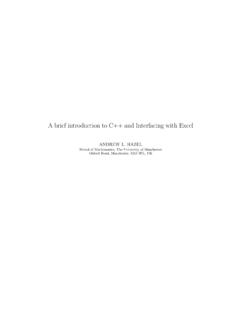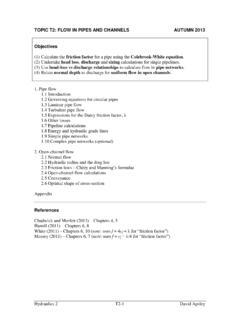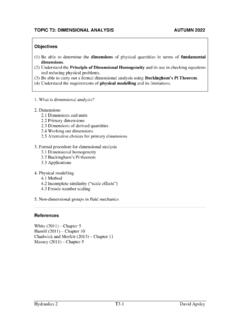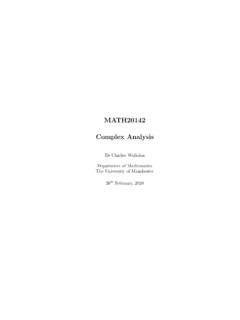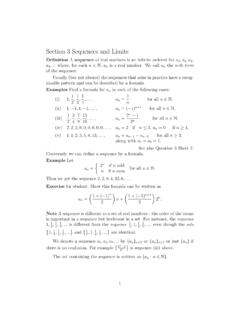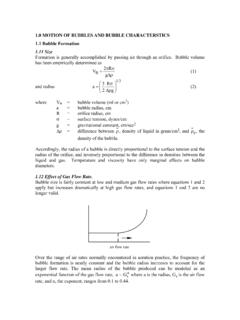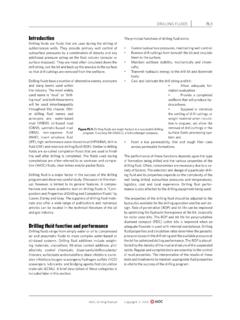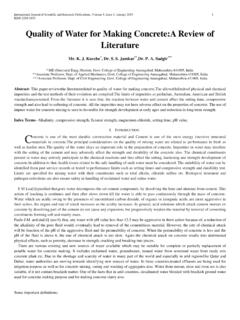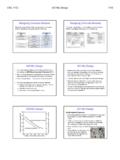Transcription of Hydraulics 1: Course notes
1 G F Lane-Serff 1 18-Feb-09 Hydraulics 1: Course notes Staff Dr G F Lane-Serff Extn 64602, room P/B20, Course Outline Hydraulics I A Fluid properties A1 Introduction: Fluids, continuum and density A2 Viscosity, surface tension and pressure A3 Tutorial: fluid properties B Hydrostatics B1 Hydrostatic pressure and the hydrostatic equation B2 Pressure measurement B3 Hydrostatic force on a plane surface B4 Buoyancy and Archimedes Principle B5 Hydrostatic force on a curved surface B6 Tutorial: Hydrostatics C Kinematics and continuity C1 Kinematics C2 Conservation of mass: continuity C3 Tutorial: Kinematics and continuity D Energy and momentum: Principles D1 Conservation of energy: Bernoulli's Equation D2 Bernoulli's Equation: Applications to flow measurement D3 Momentum principle: control volumes D4 Momentum principle: open channel flow D5 Tutorial: forces and hydraulic jumps E Pipeflow E1 Reynolds Experiment: Laminar and turbulent flow E2 Pipeflow: laminar flow E3 Flow from static reservoir (no energy losses) E4 Turbulent flow and head loss E5 Pipeflow: other head losses E6 Tutorial: Pipeflow F Energy and momentum: further applications F1 Sharp expansions and orifice meters F2 Momentum principle: effects of gravity F3 Tutorial: Gravity and flow measurement Assessment Coursework (laboratory work and problems): Fluid properties and hydrostatics 5% Momentum and energy 5% Pipeflow network design project 10% Exam.
2 Four out of six questions (free choice) 80% Books Massey BS (revised Ward-Smith), Mechanics of Fluids. 532 Chadwick AJ and Morfett JC (and Borthwick M, for later editions), Hydraulics in Civil and Environmental Engineering. 627 Hamill L, Understanding Hydraulics . 627 White FM, Fluid Mechanics. 532 Douglas JF and Matthew RD, Solving Problems in Fluid Mechanics. 532 Featherstone RE and Nalluri, Civil Engineering Hydraulics . 627 G F Lane-Serff 2 18-Feb-09 Hydraulics I A Fluid properties A1 Introduction: Fluids, continuum and density Definition of a fluid A fluid is a substance that flows. A fluid deforms continuously under the influence of an applied force, whereas a solid deforms a finite amount and then resists further deformation. This is because a solid can sustain a static internal shear stress whereas a fluid cannot.
3 The molecules of a fluid are not held in a fixed arrangement and can move past each other. Fluids include liquids and gases, and for civil engineers the most important fluids are water and air. As civil engineers, you need to understand the behaviour of fluids in both the built and natural environment. Engineers study flow in reservoirs, pipes, water and waste water treatment, and building ventilation, and also river flooding, groundwater flows, waves and wind loading on structures. Continuum Hypothesis Although a fluid is made up of individual molecules, at any scale significantly larger than the separation between molecules we can approximate the fluid as effectively continuous. This means we can regard properties such as temperature, pressure, density and velocity as functions of positions in space, and apply differential calculus to derive equations.
4 There are applications where this approach is not valid: these include nanotechnology (operating at scales comparable to those of the fluid molecules) or in environments where the molecular separation becomes significant compared with the scale of motion we are interested in ( aerospace applications at the edge of the atmosphere). Density Density is defined as mass per unit volume. It is usually denoted by the Greek letter . In SI units density is given in kg m-3. In general the density can vary at different points in space and at different times so (x,t), although we will generally deal with uniform fixed density. The typical density of ( fresh ) water is approximately water = 1000 kg m-3, and changes relatively little at normal temperatures and pressures. However, we will also consider problems where we have seawater rather than fresh water .
5 The salt in seawater increases the density, so that a typical seawater density is seawater ~ 1026 to 1028 kg m-3 (depending on the salt concentration), while water in estuaries will lie somewhere between the fresh water and seawater values. A typical air density is air ~ kg m-3, but like all gases, the density of air varies more with pressure and temperature than the density of water . This is because gases are more easily compressed than liquids. We will discuss this in more detail later. Specific weight Whereas density is mass per unit volume, specific weight is weight per unit volume: = g. Relative density or specific gravity The relative density is the density relative to some standard or reference density. Generally only used for liquids rather than gases, and so the reference density is often the density of water .
6 The relative density is sometimes referred to as the specific gravity ( ). Thus if a manometer fluid has a specific gravity of , then it has a density of 750 kg m-3. Note that relative density has no units ( dimensionless ). G F Lane-Serff 3 18-Feb-09 A2 Viscosity, surface tension and pressure Viscosity As the fluid molecules move past each other there is a resistance to this relative motion. While the stress in a solid depends on the amount of deformation (strain) of the solid, for a fluid it is the rate of deformation (strain rate) that is related to the stress. The velocity profile in a fluid near a solid boundary typically has the form shown below: Fluid further from the boundary is moving faster, and the relative motion of one layer past another is resisted by intermolecular forces in the fluid. The resistance is in the form of a stress (a force per unit area), and is generally found to be linearly dependent on the strain rate (shear or velocity gradient).
7 Thus the stress, , is given by = dudz . The constant of proportionality is known as the viscosity (or coefficient of viscosity or dynamic viscosity) and is usually denoted by . Stress has units of force/area: N m-2 or Pa, while shear has units of s-1. Thus the units of viscosity can be written as Pa s, or alternatively as kg m-1 s-1. Fluids for which there is a linear relation between stress and shear are known as Newtonian fluids, and include water and air. Typical values for viscosity are: air = 10-5 kg m-1 s-1, water = 10-3 kg m-1 s-1, while glycerin = kg m-1 s-1. However, viscosity depends strongly on temperature. The force acts to oppose the motion, so in the example above there is a force by the fluid on the boundary tending to move the boundary to the right (and an equal and opposite force on the fluid slowing it down).
8 The fluid in contact with the boundary cannot move (u = 0) otherwise there would be an infinite viscous force. This is known as the no-slip condition. Example A square block (of side m) moving at 2 m/s on a thin (2mm) layer of water . Assuming a linear velocity profile what is the force on block? Shear = dudz = 2 = 1000 s-1 Stress = dudz = 1000 10-3 = 1 N m-2 Force = area = 1 = N. z u(z) G F Lane-Serff 4 18-Feb-09 Surface tension Any free surface (or interface between immiscible fluids) acts as if it were a sheet under uniform tension, known as surface tension. The surface tension is usually denoted by and has units of force per unit length N m-1. (It can also be regarded as an energy per unit surface area.) Across any line drawn on the surface there is a force of magnitude per unit length in a direction normal to the line and tangential to the interface.
9 Where a surface is curved ( in a drop) there must be a change in pressure across the surface to balance the surface tension. If the principle radii of curvature of the surface are R1 and R2, then p = 1R1 + 1R2 The surface tension for the interface between clean water and air at 20 C is = N m-1. Surface tension is strongly affected by the presence of surfactants (most impurities have an effect on surface tension). what is the pressure (compared to atmospheric pressure) inside a spherical water drop of diameter 1mm? Here R1 = R2 = 1 mm, p = 2 /R = 146 Pa. Contact angle Where a liquid interface intersects a solid boundary, another important property is the angle the interface makes with the boundary, known as the contact angle. This angle is highly dependent on the surface chemistry and physics of the fluids and solid.
10 < 90 liquid wets surface, > 90 (as in example) liquid is non-wetting Pressure Any plane surface within a fluid experiences a force per unit area (stress) normal to that surface called the fluid pressure (units Pa or N m-2). The pressure acts equally in all directions, and is thus a scalar quantity. Perfect gases For a gas that can be considered as made up of infinitesimally small molecules colliding with each and which does not undergo any change of state ( condensation) there is a simple relationship between pressure, temperature and density known as the equation of state: p = R T where T is the temperature in Kelvin ( above absolute zero: 0 C = K) and R is the specific gas constant. For dry air R = 287 J kg-1 K-1. From this equation we can see that as the pressure increases, so does the density as the same amount of gas is compressed into a smaller volume.

